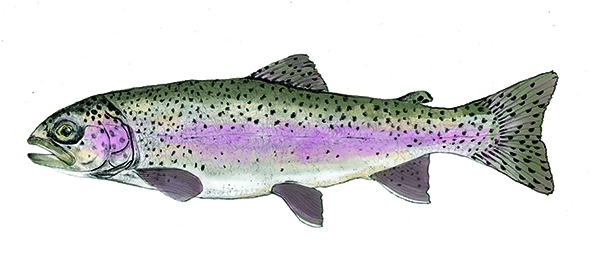Home → Fish & Wildlife → Fisheries → Species Information → Rainbow Trout
Rainbow Trout

Common Name: Rainbow Trout
Other Names: Bows
Scientific Name: Oncorhynchus mykiss
Origin: Introduced
Adult Size: Anglers normally catch fish in the 8 to 16-inch range, but occasionally fish up to 7 or 8 pounds are caught.
Identification: Coloration is highly variable depending upon size, sexual condition, and habitat. Dorsal surface ranges from a greenish yellow to a blue-gray color with silvery colored sides; and the belly area is white to pale yellow in color. Large numbers of relatively small black spots occur over the whole body, but spotting is generally heavier along dorsal areas. Rainbow trout are often recognized by a vague pink to prominent red colored band, which extends from the cheek to the base of the caudal fin.
Diet: Juvenile and adult rainbow trout are opportunistic feeders that consume a wide variety of food. Aquatic insects are the most common food item consumed, but zooplankton, terrestrial insects, crustaceans, mollusks, amphibians, leeches, and fish can be seasonally or locally important. Rainbows, like other salmonids, generally shift their diet from smaller sized food items (i.e. plankton) to larger items as they grow. Fish generally do not become an important part of the diet until adult rainbow trout reach approximately 12 inches in length.
Fishing tips:
Rainbow trout prefer cool water temperatures between 55-68oF but can tolerate a wider temperature range than other native coldwater species (i.e. brook trout and togue).
Opportunistic and aggressive feeders, they may be found close to bottom or suspended off the bottom depending on where food is located, and are likely to attack a variety of lures, flies, or bait.
In the spring and fall, rainbow trout can be caught close to shore casting with dry flies, streamers, and bright lures like spinners or spoons. Another successful method in spring time is still fishing with worms or minnows.
In the summer, trolling, casting, and still fishing are all popular and effective ways to catch this species.
Successful methods used while ice fishing include the use traps or jigging in water that is typically relatively shallow (under 15 feet) with the target depth being close to or on the bottom. If you are fishing traps and getting a lot of hit-and-run activity then try smaller minnows or other forms of bait like worms or salmon eggs. Jigging is typically far more effective than traps for this species.
Interesting facts:
Rainbow trout are native only to western portions of North America located west of the Continental Divide. However, due to their popularity they have been introduced to every continent except Antarctica.
Unlike most of the other salmonids in Maine which spawn in the fall, rainbow trout spawn in the spring.
Management: Rainbow trout are nonnative to Maine, but have been periodically stocked by Federal and State agencies since the 1930’s. The Maine Department of Inland Fisheries and Wildlife established a regular, but relatively small rainbow trout stocking program in 2007. The rainbow program has been well received by Maine anglers, and has provided some excellent fishing opportunities. Consequently, a gradual expansion of the rainbow program is anticipated; however, it will likely remain limited due to concerns regarding interspecific impacts with Maine’s native salmonid species.